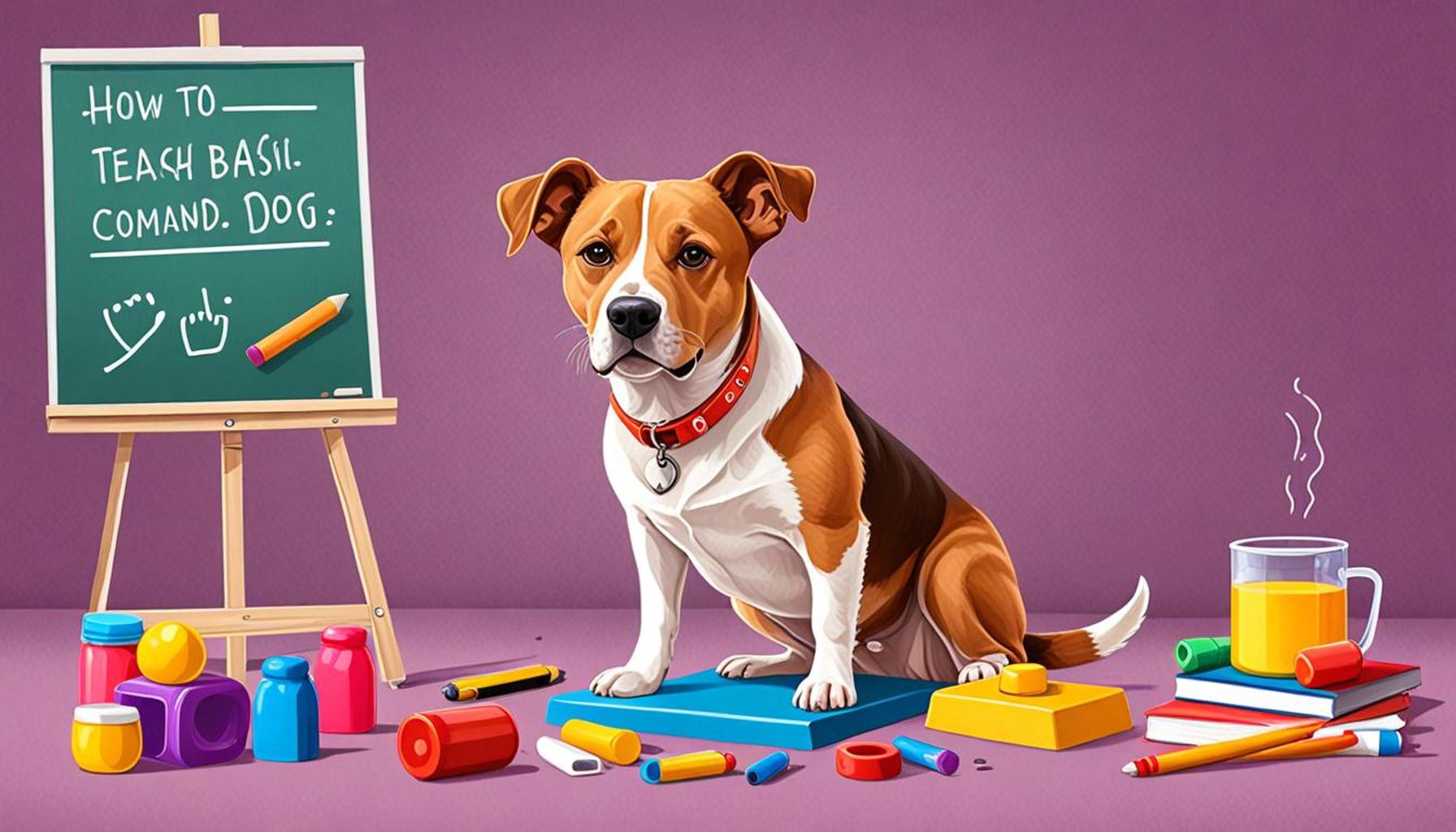Teach Your Dog Basic Commands Effective Training Tips Techniques

Unlocking the Potential of Communication with Your Dog
Training your dog is not just about teaching them tricks; it’s about establishing a strong bond that enhances communication and understanding. Basic commands like “sit,” “stay,” and “come” are essential for your dog’s safety and well-being, allowing them to navigate the world with confidence. As a responsible pet owner, knowing how to effectively convey these commands is crucial in fostering a harmonious relationship with your furry friend.
Understanding the significance of training goes beyond mere obedience. It can lead to improved behavior both at home and in public places, ultimately creating a more enjoyable experience for you and your dog. Furthermore, a well-trained dog is often happier, as they know what is expected of them, reducing confusion and anxiety.
In this article, we’ll explore a ranking of the Top 5 effective training tips that will help you teach your dog basic commands. From simple techniques to recommended resources, we have compiled strategies that are essential for any dog owner. Get ready to transform your training experience and unlock your dog’s potential!
DISCOVER MORE: Click here to learn about safe pet-friendly beaches for your furry friend!
Top 5 Tips for Teaching Basic Commands to Your Dog: Effective Training Tips
Training your dog can be a deeply fulfilling experience. Not only does it ensure your furry friend is well-behaved and safe, but it also fortifies the bond you share. Teaching basic commands such as “sit,” “stay,” and “come” lies at the core of this training journey. Mastering these fundamental commands paves the way for a harmonious coexistence between you and your dog. This article explores the top five effective tips to guide you through this process, ranked from least to most effective.

5. Use Short Training Sessions
Effective training requires a structured approach that resonates with your dog’s natural attention span. Dogs have notoriously short periods of focus, and trying to extend training beyond those limits can lead to unnecessary frustration. That’s why it is essential to keep your training sessions short and engaging, typically no longer than 5 to 10 minutes.
Short, frequent sessions spaced throughout the day offer numerous benefits:
- Break down commands into smaller, manageable steps. This helps your dog grasp each aspect of a command before moving to more complex instructions.
- Aim for multiple short sessions rather than one long session. Repetition is key to learning and helps reinforce behavior.
- Always end on a positive note, even if full mastery hasn’t been achieved. This promotes enthusiasm and eagerness in future training sessions.
Besides, consider your dog’s mood and energy levels when planning sessions. A well-rested, focused dog is far more receptive to learning than one that is tired or overly excited.
4. Use Positive Reinforcement
The effectiveness of your training largely hinges on the way you reward your dog. Positive reinforcement is not only an effective training method but also the most humane. By using treats, praise, or toys as rewards, you create a positive association with the commands, encouraging your dog to repeat them.
Make the most out of positive reinforcement with these practices:
- Use high-value treats, those your dog loves the most, to spark more interest and enthusiasm during training.
- Be consistent in your rewards. Consistency in rewarding reinforces behavior more effectively over time.
- Gradually phase out treats as your dog becomes proficient with commands, transitioning to verbal praise to ensure long-term adherence to desired behaviors.
Studies show that positive reinforcement leads to a reduction in anxiety and increased trust between you and your dog, compared to aversive training methods.
3. Be Consistent with Commands
Consistency is the backbone of effective dog training. Overwhelming your dog with different words or signals for the same command can cause confusion, ultimately setting back your progress. Choose specific commands and adhere to them consistently.
Here’s how to maintain consistency:
- Ensure all family members use the same commands. This uniformity helps your dog learn and respond more efficiently.
- Maintain a consistent tone of voice to avoid conveying mixed signals.
- Practice commands in varying environments, ranging from quiet home settings to bustling parks. This diversifies your dog’s learning experiences and solidifies their understanding.
A consistent training regimen not only speeds up the learning process but also establishes clear communication standards for your dog to follow.
2. Gradually Increase the Difficulty of Commands
Once your dog becomes comfortable with basic commands, it may be time to introduce more challenging tasks. Gradually increasing the difficulty keeps your dog mentally stimulated and engaged in training.
Consider the following steps for advancing your training:
- Start with basic commands like “sit,” “stay,” and “come.” These form the foundation for more elaborate instructions.
- Introduce distractions to test your dog’s concentration and responsiveness while mastering these commands.
- Tackle more complex tasks such as “leave it” or “heel” once basic commands are solidified.
Challenge your dog without overwhelming them. A trajectory of gradual progression capitalizes on their growing capabilities while preventing frustration or loss of interest.
1. Build a Strong Bond Through Play and Interaction
The cornerstone of effective training is not just the commands themselves but the relationship you cultivate with your dog. When your dog views you as a leader and trusts you, they are more likely to respond positively to commands. Engaging your dog in various activities builds this essential trust.
Here’s how you can strengthen that bond:
- Incorporate play into training sessions to make learning enjoyable and less of a chore for your dog.
- Spend quality time outside of formal training, such as enjoying walks, playing fetch, or exploring new parks.
- Consistently show affection and encouragement. This nurtures a sense of security and reinforces positive behaviors.
Engagement beyond training sessions not only improves your dog’s command compliance but enriches your mutual bond, making training an extension of your everyday interactions rather than an isolated task.
By following these strategies, you will not only effectively teach your dog basic commands but will also cultivate a deep, trusting relationship. Remember, patience and consistency are the keystones of successful dog training!
Teaching basic commands to your dog is not just a rewarding experience for you as an owner but also a significant benefit for your furry friend. It helps foster a strong communication bond, enhances the pet-owner relationship, and ultimately leads to a well-mannered companion. Here are some effective tips and strategies for successfully training your dog:First, focus on consistency. Use the same commands and gestures each time you ask your dog to perform a task. Pronunciation and body language are key here. This helps the dog to associate specific commands with actions effectively. For instance, when teaching the “Sit” command, ensure you consistently use the word “Sit” while simultaneously indicating the sitting motion with your hand. The repetition of commands aids in solidifying the learning process.Moreover, setting a positive atmosphere during training sessions is crucial. Make sure that these moments are enjoyable for your dog. Employ treats or toys as rewards for successful commands, but it’s important to be mindful of portion control to prevent overfeeding. Treats should be small and given only during training to maintain motivation without compromising your dog’s health. Praise and affection are equally valuable; a simple “Good boy!” or a scratch behind the ears can go a long way in encouraging your dog.Incorporating play into the training process can also make learning more engaging. Utilize short sessions filled with fun activities, which keep your dog eager to learn rather than bored. For example, you can combine the “Come” command with a game of fetch. This approach not only reinforces the command but also creates a dynamic, enjoyable environment that aids in learning.Finally, patience is critical. Every dog learns at its own pace, influenced by their breed, age, and individual personality. When your dog struggles to grasp a command, avoid showing frustration. Instead, break the command down into smaller, manageable steps. Progress may be slow, but consistent training will yield results over time.Engaging your dog’s mind is equally important. Enrichment activities such as puzzle toys or hide-and-seek games can aid in stimulating their mental faculties while reinforcing the commands they’ve learned. Training shouldn’t be limited to obedience; it can and should be an avenue for bonding, trust building, and mutual respect.As you embark on this journey of training your dog, remember that every moment is an opportunity for growth, both for you and your canine companion. Every command you teach lays a foundation for a lifetime of understanding, connection, and joy in each other’s company.
DISCOVER MORE: Click here to learn how to create the perfect routine for your energetic pup
Frequently Asked Questions About Teaching Basic Commands to Your Dog
What age is best to start training my dog in basic commands?
Puppies can start learning basic commands as early as eight weeks old. At this age, they are highly receptive and can absorb new information quickly. However, it’s never too late to start training your dog. Adult dogs are perfectly capable of learning new commands, although the training might require more patience and consistency. Early socialization and training can greatly impact a dog’s behavior and adaptability, so starting as soon as possible is beneficial.
What are the most effective methods for training my dog?
There are various methods for training dogs, but the most effective ones often involve positive reinforcement. This includes offering treats, praise, and affection when your dog successfully follows a command. Clicker training is another popular method, where a click sound is used to mark the desired behavior, followed by a reward. Consistency is key in any method you choose. Repetition and maintaining a routine can speed up the learning process for your furry friend.
How long does it take for a dog to learn a new command?
The time it takes for a dog to learn a new command can vary widely based on the individual dog’s age, breed, and learning style, as well as the trainer’s consistency. Generally, with regular practice, a dog can learn a basic command in a matter of one to two weeks. Reinforcement of the command is crucial even after the initial learning phase. Practicing daily and gradually increasing the complexity will help ensure long-term retention of the command.
Why is my dog not responding to commands?
There could be several reasons why a dog does not respond to commands. Distractions in the environment, not enough motivation, or inconsistent training can all play a role. It’s important to ensure that the training environment is calm and that your dog is properly motivated, which often means ensuring they are interested in the treat or reward being offered. Also, be patient and adjust the intensity and duration of the training sessions to the dog’s comfort level and capability.
Is punishment an effective approach in dog training?
While it may be tempting to use punishment to curb unwanted behaviors, evidence suggests that positive reinforcement is more effective for long-term behavior change. Punishment can cause fear and anxiety in dogs, which may lead to more behavioral problems. Instead, focus on reinforcing the behaviors you want to see more of through positive reinforcement techniques, and redirect unwanted behaviors towards more acceptable actions.
DISCOVER MORE: Click here to learn how to keep your pet healthy during the holidays
Conclusion: Effective Training for a Well-Behaved Companion
Training your dog to follow basic commands is not just about enforcing discipline; it’s about building a bridge of understanding between you and your furry companion. This article has walked you through several effective training techniques and emphasized the key role of patience and consistency in this process. Teaching commands like sit, stay, and come are foundational steps that can enhance safety, improve communication, and significantly boost the quality of life for both you and your dog.
Key takeaways from this discussion include the importance of positive reinforcement—rewarding desired behaviors with treats, praise, or playtime—to encourage repetition. Starting with short, focused sessions helps to maintain your dog’s attention, avoiding frustration and fatigue. Additionally, the consistent use of verbal cues and hand signals is essential in reinforcing the commands you want your dog to learn.
Moreover, the training process is an excellent opportunity to deepen your bond. Dogs are inherently eager to please, and understanding their unique learning pace and adapting your methods accordingly can lead to highly successful outcomes. While mastering the basic commands is essential, this is just the beginning. Every dog is different, and unlocking their full potential through tailored, ongoing training can lead to a happier and healthier companionship.
In conclusion, the journey of training your dog with these basic commands is rewarding and crucial, fostering an environment where both you and your dog thrive. The information presented leads you to reflect on your current training practices, encouraging further exploration and adaptation to the unique dynamics of your relationship with your pet.


